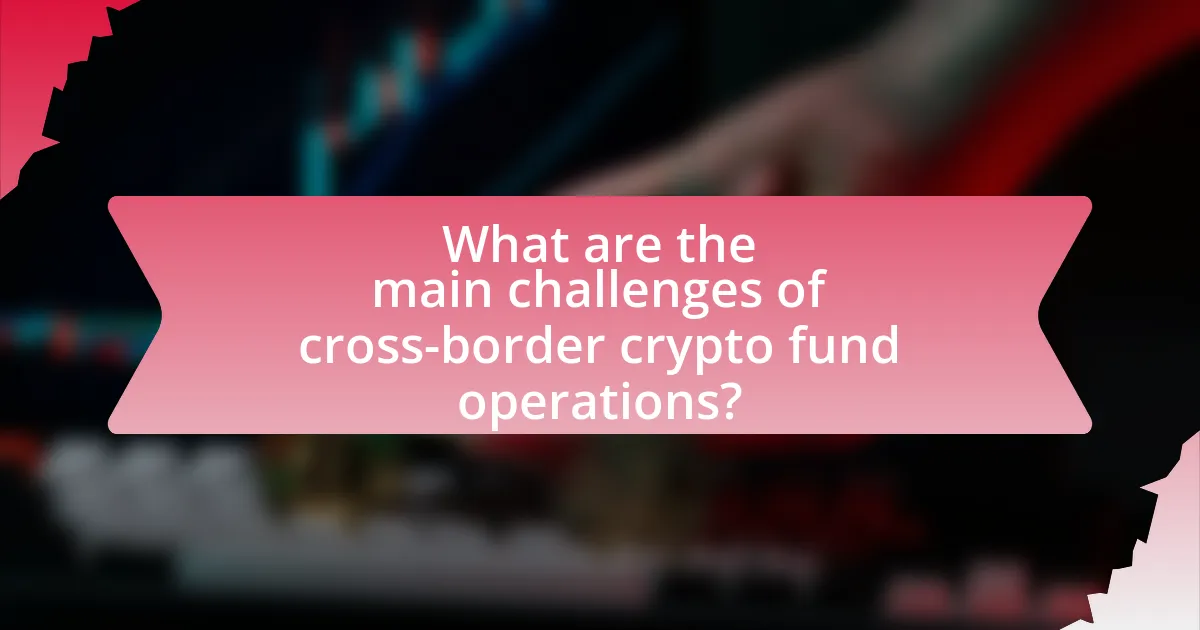The article focuses on the challenges faced by cross-border crypto fund operations, highlighting key issues such as regulatory compliance, taxation, and varying legal frameworks across different jurisdictions. It discusses how regulatory differences impact market access and operational efficiency, as well as the specific regulations that vary between countries, including securities classification and anti-money laundering requirements. Additionally, the article addresses operational risks, currency volatility, security threats, and tax implications that influence the management of crypto funds internationally. Best practices for navigating these challenges, including compliance strategies and risk management frameworks, are also outlined to enhance operational efficiency and legal adherence in a complex global landscape.

What are the main challenges of cross-border crypto fund operations?
The main challenges of cross-border crypto fund operations include regulatory compliance, taxation issues, and varying legal frameworks across jurisdictions. Regulatory compliance is complex due to the lack of uniform regulations governing cryptocurrencies globally, leading to uncertainty for fund managers. Taxation issues arise from differing tax treatments of crypto assets in various countries, complicating profit repatriation and tax reporting. Additionally, varying legal frameworks can create obstacles in fund structuring and investor protection, as laws regarding securities and investment funds differ significantly from one jurisdiction to another. These challenges can hinder operational efficiency and increase costs for crypto funds operating internationally.
How do regulatory differences impact cross-border crypto fund operations?
Regulatory differences significantly impact cross-border crypto fund operations by creating compliance challenges that can hinder market access and operational efficiency. For instance, varying regulations regarding securities classification, anti-money laundering (AML) requirements, and taxation across jurisdictions can lead to increased operational costs and legal complexities for crypto funds. A study by the Cambridge Centre for Alternative Finance highlights that 60% of crypto firms face regulatory uncertainty, which affects their ability to operate internationally. This uncertainty can deter investment and limit the growth potential of crypto funds in different markets.
What specific regulations vary between countries affecting crypto funds?
Regulations affecting crypto funds vary significantly between countries, primarily in areas such as taxation, anti-money laundering (AML) requirements, and securities classification. For instance, the United States classifies cryptocurrencies as securities under certain conditions, requiring compliance with the Securities and Exchange Commission (SEC) regulations, while countries like Switzerland have established a more favorable regulatory framework that categorizes cryptocurrencies as assets, allowing for greater flexibility in fund operations. Additionally, the European Union’s Markets in Crypto-Assets (MiCA) regulation aims to create a unified regulatory framework across member states, contrasting with jurisdictions like China, which has imposed strict bans on cryptocurrency transactions and initial coin offerings (ICOs). These differences create challenges for cross-border crypto fund operations, as firms must navigate a complex landscape of varying compliance requirements and legal interpretations.
How do compliance requirements differ for crypto funds in various jurisdictions?
Compliance requirements for crypto funds vary significantly across jurisdictions due to differing regulatory frameworks and legal interpretations. For instance, in the United States, crypto funds must adhere to regulations set by the Securities and Exchange Commission (SEC), which classifies many cryptocurrencies as securities, requiring registration and compliance with strict reporting standards. In contrast, jurisdictions like Switzerland have a more favorable regulatory environment, where the Swiss Financial Market Supervisory Authority (FINMA) provides clear guidelines for crypto asset management, allowing for greater flexibility in fund operations. Additionally, countries such as Malta and Singapore have established comprehensive frameworks that encourage crypto innovation while ensuring investor protection, with specific licensing requirements for crypto fund managers. These variations highlight the complexities that crypto funds face when operating cross-border, necessitating a thorough understanding of local laws and compliance obligations to mitigate legal risks.
What are the operational risks associated with cross-border crypto fund operations?
Operational risks associated with cross-border crypto fund operations include regulatory compliance challenges, cybersecurity threats, and operational inefficiencies. Regulatory compliance challenges arise due to varying legal frameworks across jurisdictions, which can lead to non-compliance and potential penalties. Cybersecurity threats are heightened in cross-border operations, as funds may face increased exposure to hacking and fraud due to the decentralized nature of cryptocurrencies. Operational inefficiencies can occur from differences in time zones, communication barriers, and varying operational practices, which can disrupt fund management and investor relations. These risks are substantiated by the increasing number of regulatory actions taken against crypto entities globally, highlighting the complexities of navigating diverse regulatory landscapes.
How does currency volatility affect cross-border crypto fund management?
Currency volatility significantly impacts cross-border crypto fund management by introducing risks related to exchange rate fluctuations. These fluctuations can lead to unpredictable changes in the value of investments when converting cryptocurrencies to fiat currencies or vice versa. For instance, a sudden depreciation of a local currency against a stable currency can diminish the value of assets held in that currency, affecting overall fund performance. According to a report by the Bank for International Settlements, currency volatility can increase transaction costs and complicate compliance with regulatory requirements, further challenging fund managers in maintaining profitability and operational efficiency in a global market.
What security risks are prevalent in cross-border crypto transactions?
Cross-border crypto transactions face several security risks, including fraud, hacking, and regulatory compliance issues. Fraud can occur through phishing attacks or scams that exploit the anonymity of cryptocurrency, leading to significant financial losses. Hacking poses a threat as cybercriminals target exchanges and wallets, with reports indicating that over $1.9 billion was stolen from cryptocurrency exchanges in 2020 alone. Additionally, regulatory compliance issues arise due to varying laws across jurisdictions, which can lead to legal penalties and increased scrutiny from authorities. These risks highlight the need for robust security measures and awareness in cross-border crypto operations.
How do tax implications influence cross-border crypto fund operations?
Tax implications significantly influence cross-border crypto fund operations by determining the financial viability and regulatory compliance of such investments. Different jurisdictions impose varying tax rates on capital gains, income, and transactions involving cryptocurrencies, which can affect the overall returns for investors. For instance, countries like Germany do not tax long-term capital gains on cryptocurrencies held for over a year, while the United States taxes them as property, leading to capital gains tax liabilities. This disparity can drive fund managers to strategically choose locations for fund registration and operations to minimize tax burdens and enhance profitability. Additionally, compliance with international tax regulations, such as the OECD’s Common Reporting Standard, necessitates transparency and reporting, which can complicate operations and increase administrative costs for cross-border crypto funds.
What are the common tax challenges faced by cross-border crypto funds?
Cross-border crypto funds commonly face tax challenges such as differing regulatory frameworks, tax residency issues, and the complexity of reporting requirements. These funds often operate in multiple jurisdictions, leading to confusion over which country’s tax laws apply. For instance, the OECD’s guidelines on Base Erosion and Profit Shifting highlight the difficulties in determining tax residency for entities involved in international transactions, which can result in double taxation. Additionally, the lack of clarity in how cryptocurrencies are classified—whether as currency, property, or securities—further complicates tax obligations, as seen in various countries’ differing approaches to crypto taxation.
How can crypto funds navigate international tax treaties?
Crypto funds can navigate international tax treaties by understanding the specific provisions of each treaty that affect their operations and ensuring compliance with local tax laws. This involves conducting thorough research on the treaties between the countries where the fund operates and where its investors reside, as these treaties often provide benefits such as reduced withholding tax rates on dividends, interest, and royalties. Additionally, crypto funds should engage tax professionals who specialize in international tax law to interpret the treaties accurately and apply them effectively, thereby minimizing tax liabilities and avoiding double taxation. For instance, the OECD Model Tax Convention serves as a framework for many bilateral treaties, providing guidelines on how to allocate taxing rights between countries.
What technological barriers exist in cross-border crypto fund operations?
Technological barriers in cross-border crypto fund operations include issues related to interoperability, regulatory compliance, and cybersecurity. Interoperability challenges arise from the lack of standardized protocols across different blockchain networks, making it difficult for funds to operate seamlessly across borders. Regulatory compliance is complicated by varying legal frameworks in different jurisdictions, which can hinder the implementation of technology solutions that meet all local requirements. Additionally, cybersecurity risks, such as hacking and fraud, pose significant threats to the integrity and security of cross-border transactions, as evidenced by the increasing number of cyberattacks targeting crypto exchanges and wallets.
How does blockchain technology facilitate or hinder cross-border operations?
Blockchain technology facilitates cross-border operations by providing a decentralized and transparent ledger that enhances trust and reduces transaction costs. This technology allows for real-time settlement of transactions, eliminating the need for intermediaries such as banks, which can slow down processes and increase fees. For instance, a study by the World Economic Forum in 2020 highlighted that blockchain could reduce cross-border payment costs by up to 80% and increase transaction speed from days to minutes. However, blockchain can also hinder cross-border operations due to regulatory uncertainties and varying legal frameworks across countries, which can complicate compliance and create barriers to entry for businesses.
What role do digital wallets play in cross-border crypto fund transactions?
Digital wallets facilitate cross-border crypto fund transactions by providing a secure and efficient means for users to store, send, and receive cryptocurrencies across different jurisdictions. They enable instant transfers without the need for traditional banking intermediaries, which can be slow and costly due to currency conversion fees and regulatory hurdles. For instance, according to a report by the Cambridge Centre for Alternative Finance, the use of digital wallets has significantly increased the speed of transactions, allowing users to bypass lengthy processing times associated with conventional banking systems. This efficiency is crucial in a globalized economy where timely fund transfers can impact business operations and investment opportunities.
What best practices can mitigate challenges in cross-border crypto fund operations?
Implementing robust compliance frameworks is a best practice that can mitigate challenges in cross-border crypto fund operations. These frameworks should include adherence to local regulations, anti-money laundering (AML) protocols, and know-your-customer (KYC) requirements, which are essential for maintaining legal standing in multiple jurisdictions. For instance, the Financial Action Task Force (FATF) provides guidelines that many countries adopt, emphasizing the importance of compliance in preventing illicit activities. Additionally, utilizing blockchain technology for transparent transaction tracking can enhance accountability and trust among stakeholders, further reducing operational risks.
How can crypto funds ensure compliance across multiple jurisdictions?
Crypto funds can ensure compliance across multiple jurisdictions by implementing a robust regulatory framework that includes thorough legal analysis, adherence to local laws, and continuous monitoring of regulatory changes. This involves engaging legal experts familiar with the specific regulations in each jurisdiction where the fund operates, ensuring that all activities align with Anti-Money Laundering (AML) and Know Your Customer (KYC) requirements. For instance, the Financial Action Task Force (FATF) provides guidelines that many jurisdictions adopt, emphasizing the need for crypto funds to comply with international standards. Additionally, utilizing technology such as compliance software can help automate the monitoring of transactions and regulatory updates, thereby enhancing compliance efforts.
What strategies can be employed to manage operational risks effectively?
To manage operational risks effectively in cross-border crypto fund operations, organizations should implement a comprehensive risk management framework that includes risk identification, assessment, mitigation, and monitoring. This framework should involve regular audits and compliance checks to ensure adherence to regulatory requirements across different jurisdictions, as operational risks can arise from varying legal standards and practices.
Additionally, employing advanced technology solutions, such as blockchain for transparency and security, can significantly reduce risks associated with fraud and data breaches. According to a report by the World Economic Forum, the use of blockchain technology can enhance operational efficiency and reduce the likelihood of errors in transactions, thereby mitigating operational risks.
Furthermore, establishing a robust training program for employees on risk awareness and crisis management can prepare teams to respond effectively to potential operational disruptions. Research from the Institute of Risk Management indicates that organizations with well-trained staff are better equipped to handle unexpected operational challenges, leading to improved resilience.















